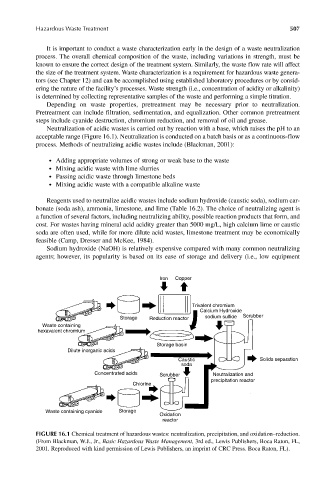Page 536 - Materials Chemistry, Second Edition
P. 536
CAT3525_C16.qxd 1/27/2005 12:42 PM Page 507
Hazardous Waste Treatment 507
It is important to conduct a waste characterization early in the design of a waste neutralization
process. The overall chemical composition of the waste, including variations in strength, must be
known to ensure the correct design of the treatment system. Similarly, the waste flow rate will affect
the size of the treatment system. Waste characterization is a requirement for hazardous waste genera-
tors (see Chapter 12) and can be accomplished using established laboratory procedures or by consid-
ering the nature of the facility’s processes. Waste strength (i.e., concentration of acidity or alkalinity)
is determined by collecting representative samples of the waste and performing a simple titration.
Depending on waste properties, pretreatment may be necessary prior to neutralization.
Pretreatment can include filtration, sedimentation, and equalization. Other common pretreatment
steps include cyanide destruction, chromium reduction, and removal of oil and grease.
Neutralization of acidic wastes is carried out by reaction with a base, which raises the pH to an
acceptable range (Figure 16.1). Neutralization is conducted on a batch basis or as a continuous-flow
process. Methods of neutralizing acidic wastes include (Blackman, 2001):
● Adding appropriate volumes of strong or weak base to the waste
● Mixing acidic waste with lime slurries
● Passing acidic waste through limestone beds
● Mixing acidic waste with a compatible alkaline waste
Reagents used to neutralize acidic wastes include sodium hydroxide (caustic soda), sodium car-
bonate (soda ash), ammonia, limestone, and lime (Table 16.2). The choice of neutralizing agent is
a function of several factors, including neutralizing ability, possible reaction products that form, and
cost. For wastes having mineral acid acidity greater than 5000 mg/L, high calcium lime or caustic
soda are often used, while for more dilute acid wastes, limestone treatment may be economically
feasible (Camp, Dresser and McKee, 1984).
Sodium hydroxide (NaOH) is relatively expensive compared with many common neutralizing
agents; however, its popularity is based on its ease of storage and delivery (i.e., low equipment
Iron Copper
Trivalent chromium
Calcium Hydroxide
Storage Reduction reactor sodium sulfide Scrubber
Waste containing
hexavalent chromium
Storage basin
Dilute inorganic acids
Caustic Solids separation
soda
Concentrated acids Scrubber Neutralization and
precipitation reactor
Chlorine
Waste containing cyanide Storage
Oxidation
reactor
FIGURE 16.1 Chemical treatment of hazardous wastes: neutralization, precipitation, and oxidation–reduction.
(From Blackman, W.J., Jr., Basic Hazardous Waste Management, 3rd ed., Lewis Publishers, Boca Raton, FL,
2001. Reproduced with kind permission of Lewis Publishers, an imprint of CRC Press. Boca Raton, FL).

